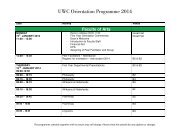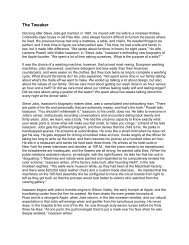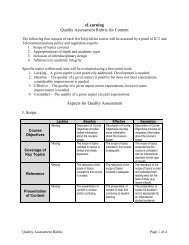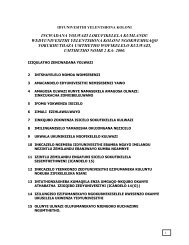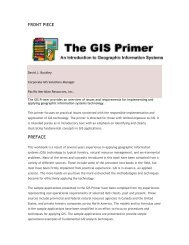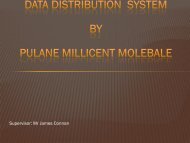GOVERNMENT PROCUREMENT AS A POLICY TOOL IN SOUTH ...
GOVERNMENT PROCUREMENT AS A POLICY TOOL IN SOUTH ...
GOVERNMENT PROCUREMENT AS A POLICY TOOL IN SOUTH ...
Create successful ePaper yourself
Turn your PDF publications into a flip-book with our unique Google optimized e-Paper software.
JOURNAL OF PUBLIC <strong>PROCUREMENT</strong>, VOLUME 6, ISSUE 3, 193-217 2006<br />
<strong>GOVERNMENT</strong> <strong>PROCUREMENT</strong> <strong>AS</strong> A <strong>POLICY</strong> <strong>TOOL</strong> <strong>IN</strong><br />
<strong>SOUTH</strong> AFRICA<br />
Phoebe Bolton*<br />
ABSTRACT. Prior to 1994, the government procurement system in South<br />
Africa favoured large and established businesses and it was very difficult for<br />
newly established business to enter the procurement system. In 1994, however,<br />
government procurement was granted constitutional status, and was recognised<br />
as a means of addressing past discriminatory policies and practices. This paper<br />
critically analyses the way in which provision has been made in legislation for<br />
the use of procurement as a policy tool. It is argued that the use of procurement<br />
as a policy tool in South Africa is justified. On the whole, the primary legislation<br />
dealing with the use of procurement as a policy tool offers an adequate effect to<br />
the constitutionally prescribed use of procurement as a policy tool.<br />
<strong>IN</strong>TRODUCTION<br />
The size and volume of government procurement contracts facilitates<br />
the government’s decisions with regarding when and whom it contracts<br />
with, and these decisions affect a number of issues. Aside from<br />
government procurement being “business,” i.e., the acquisition of goods<br />
and services on the best possible terms, it also has broader social,<br />
economic and political implications (Labuschagne, 1985; Morris, 1998;<br />
Turpin, 1972). Government procurement is and has, for example, often<br />
been used to promote aims which are, arguably, secondary to the primary<br />
aim of procurement. Examples include using procurement to promote<br />
social, industrial or environmental policies (Arrowsmith, Linarelli &<br />
Wallace, 2000; Cane, 2004; Turpin, 1989). It is in this regard that<br />
government procurement is of particular significance to South Africa.<br />
Due to the discriminatory and unfair practices of the past, a number of<br />
-------------------<br />
* Phoebe Bolton; B Proc, LLB, LLM, LLD, is a senior lecturer, Law Faculty,<br />
University of the Western Cape, South Africa. Her research interests include<br />
government contracts and government procurement.<br />
Copyright © 2006 by PrAcademics Press
194 BOLTON<br />
groups in South Africa were prevented from accessing government<br />
contracts. Prior to 1994, the government procurement system was geared<br />
towards large and established contractors. Thus new contractors found it<br />
very difficult to participate in government procurement procedures<br />
(Minister of Finance, 1997). The aim of this paper is to evaluate the way<br />
in which the South African government has made provision for the use of<br />
procurement as a means to address past imbalances.<br />
The paper will begin with an overview of the policy objectives<br />
underlying the use of procurement as a policy tool. Attention will then be<br />
given to two constitutional principles that directly impact on the use of<br />
procurement as a policy tool, i.e., the right to equality and the attainment<br />
of value for money. Next, attention will be given to the constitutional<br />
framework of preferential procurement in South Africa. Specific<br />
attention will be given to section 217 of the Constitution of the Republic<br />
of South Africa (108 of 1996) which makes provision for the use of<br />
procurement as a policy tool and the legislation that has been enacted to<br />
give effect to section 217, i.e. the Preferential Procurement Policy<br />
Framework Act (5 of 2000) – hereafter the Procurement Act. Reference<br />
will be made to other legislation that prescribes the use of procurement<br />
as a policy tool, for example, the Public Finance Management Act (1 of<br />
1999, as amended by Act 29 of 1999) – hereafter the PFMA, the Broad-<br />
Based Black Economic Empowerment Act (53 of 2003) – hereafter the<br />
BBBEEA, the Local Government: Municipal Finance Management Act<br />
(56 of 2003) – hereafter the MFMA and the Local Government:<br />
Municipal Systems Act (32 of 2000, as amended by Act 44 of 2003) –<br />
hereafter the Municipal Systems Act. The primary focus, however, will<br />
be on the Procurement Act and the Regulations thereto (Preferential<br />
Procurement Regulations, Government Notice R725, Government<br />
Gazette No. 22549, 10 August 2001) which were enacted to give effect<br />
to section 217(3) of the Constitution. 1 The Procurement Act and<br />
Regulations will be critically analysed and attention will be given to the<br />
way in which the courts have interpreted and applied the Act and<br />
Regulations.<br />
OVERVIEW OF <strong>POLICY</strong> OBJECTIVES<br />
Using procurement as a policy tool can also be referred to as “wealth<br />
redistribution” – using procurement to channel funds to discrete<br />
categories of economic actors (e.g., previously disadvantaged groups in
<strong>GOVERNMENT</strong> <strong>PROCUREMENT</strong> <strong>AS</strong> A <strong>POLICY</strong> <strong>TOOL</strong> <strong>IN</strong> <strong>SOUTH</strong> AFRICA 195<br />
South Africa). The freedom of governments to use procurement as a<br />
policy tool has, however, to a large extent been restrained in recent years<br />
due to the implementation of measures aimed at achieving free trade in<br />
public markets. These measures most notably include the World Trade<br />
Organisation Government Procurement Agreement (WTO GPA) and the<br />
trade restrictions in place under European Community law. This does not<br />
detract from the fact that procurement has often been, and at times still<br />
is, used by governments as a tool to implement secondary policies<br />
(Arrowsmith, 2005; Cane, 2004; Craig, 2003; McCrudden, 1999; Reich,<br />
1999; Seddon, 2004; Sparke, 1996; Turpin, 1989). A study undertaken<br />
for the European Community in 1995 (Watermeyer, 2000) indicates that<br />
procurement has been used by governments to: stimulate economic<br />
activity; protect national industry against foreign competition; improve<br />
the competitiveness of certain industrial sectors; and remedy regional<br />
disparities. It has also been employed to achieve certain more direct<br />
social policy objectives such as to: foster the creation of jobs; promote<br />
fair labour conditions; promote the use of local labour as a means to<br />
prevent discrimination against minority groups; protect the environment;<br />
encourage equality of opportunity between men and women; and<br />
promote the increased utilisation of the disabled in employment.<br />
There are numerous arguments that can be raised in favour of the use<br />
of procurement as a policy tool. One such argument is that “where<br />
properly employed, procurement may prove a useful and effective<br />
instrument” (Arrowsmith, 1995). The use of procurement is “a valid and<br />
valuable tool for the implementation of social policies; and one which<br />
should not be denied to government[s] without convincing justification”<br />
(Arrowsmith, 1995, pp. 247-248). Provided that the use of procurement<br />
as a policy tool has measurable targets; the processes used are verifiable,<br />
auditable, and transparent; and the use of procurement as a policy tool<br />
takes place within a competitive environment, procurement can to a large<br />
extent contribute to the development of growing enterprises that are able<br />
to participate equitably in the global economy (Shezi, 1998; Watermeyer,<br />
2000). It is therefore appropriate for the use of procurement as a policy<br />
tool to be regulated, but it should not be assumed that such use is<br />
“presumptively illegitimate” (McCrudden, 1999, p. 11). Contracts made<br />
by organs of state should “not be viewed solely as commercial bargains.<br />
The very power to grant contracts should be able to be utilized to<br />
advance socially desirable objectives, precisely because [organs of state]
196 BOLTON<br />
cannot be and should not be politically neutral towards such matters”<br />
(Craig, 2003, p. 141).<br />
Preferential procurement policies can also offer advantages over<br />
more direct methods of assistance because “it does not raise public<br />
spending directly…is less likely to be channeled into the purse of<br />
organized crime…[and is] more efficient than tax-financed State aid<br />
which barely reaches recipients” (Martin & Stehmann, 1991, p. 238).<br />
Procurement can furthermore be used to achieve anti-discrimination<br />
objectives in workplaces. Contracts can be denied to employers who<br />
make use of discriminatory practices. This, in turn, fosters fair<br />
competition because contracts are awarded on merit and not to<br />
contractors who violate anti-discrimination laws. In South Africa, for<br />
example, suppliers, service providers and contractors, in so far as their<br />
labour is concerned, are bound by various statutes: the Labour Relations<br />
Act (66 of 1995), the Basic Conditions of Employment Act (75 of 1997),<br />
the Employment Equity Act (55 of 1998) – hereafter the EEA, and the<br />
Occupational Health and Safety Act (85 of 1996). The non-observance of<br />
these statutes, usually to maximize profits, inevitably gives rise to unfair<br />
competitive advantages in the tendering process. It is, therefore,<br />
important to ensure that those who participate in public sector<br />
procurement adhere to labour standards. Section 53(1) of the EEA aims<br />
to ensure this and provides that “[e]very employer that makes an offer to<br />
conclude an agreement with an organ of state for the furnishing of<br />
supplies or services to that organ of state or for the hiring or letting of<br />
anything (a) must (i) if it is a designated employer, comply with [the<br />
chapters on the prohibition against unfair discrimination and affirmative<br />
action in the Act]; or (ii) if it is not a designated employer, comply with<br />
[the chapter on the prohibition against unfair discrimination].”<br />
Failure by an employer to comply with the relevant chapters may, in<br />
terms of section 53(4) of the EEA, serve as a ground for the rejection of<br />
its offer or the cancellation of the agreement. There is, of course, also the<br />
moral justification that governments should not support contractors who<br />
practice discrimination in their workplaces. Ultimately, “[p]rocurement<br />
is an important item of public expenditure with far reaching social,<br />
economic and political implications. To argue…that public procurement<br />
is a sacred cow which should be “outside the political arena” is<br />
restrictive and unwarranted. Purchasing policies pursued by public<br />
authorities should be open to modification in the light of pressing social<br />
or economic problems – even if this does require procurement decisions
<strong>GOVERNMENT</strong> <strong>PROCUREMENT</strong> <strong>AS</strong> A <strong>POLICY</strong> <strong>TOOL</strong> <strong>IN</strong> <strong>SOUTH</strong> AFRICA 197<br />
not to be guided exclusively by commercial criteria” (Morris, 1998, pp.<br />
87-88).<br />
There are two constitutional principles that directly impact on the use<br />
of procurement as a policy tool in South Africa: the right to equality and<br />
the attainment of value for money. The impact of these principles will be<br />
examined in the ensuing paragraphs.<br />
<strong>POLICY</strong> PROMOTION AND EQUALITY<br />
The equality debate in the context of government procurement is not<br />
a new phenomenon. In the South African context, the equality debate has<br />
surfaced particularly in view of the fact that the Constitution guarantees<br />
the right to equal treatment. Section 9 provides that:<br />
(1) Everyone is equal before the law and has the right to equal<br />
protection and benefit of the law.<br />
(2) Equality includes the full and equal enjoyment of all rights and<br />
freedoms. To promote the achievement of equality, legislative<br />
and other measures designed to protect or advance persons, or<br />
categories of persons, disadvantaged by unfair discrimination<br />
may be taken.<br />
(3) The state may not unfairly discriminate directly or indirectly<br />
against anyone on one or more grounds including race, gender,<br />
sex, pregnancy, marital status, ethnic or social origin, colour,<br />
sexual orientation, age, disability, religion, conscience, belief,<br />
culture, language and birth.<br />
(4) No person may unfairly discriminate directly or indirectly<br />
against anyone on one or more grounds in terms of subsection<br />
(3). National legislation must be enacted to prevent or prohibit<br />
unfair discrimination.<br />
(5) Discrimination on one or more of the grounds listed in<br />
subsection (3) is unfair unless it is established that the<br />
discrimination is fair.<br />
On a formal view of equality, it may be argued that using<br />
procurement as a policy tool, i.e., affording preferential treatment to<br />
certain sections of the South African community when awarding<br />
government contracts, is unconstitutional based on sections 9(1) and 9(3)<br />
of the Constitution. The Constitutional Court has, however, held that the
198 BOLTON<br />
right to equality in the 1993 and 1996 Constitutions refers to a<br />
“substantive” conception of equality as opposed to a “formal” conception<br />
of equality (President of the Republic of South Africa and Another v<br />
Hugo 1997 (6) BCLR 708 (CC); Harksen v Lane NO and Others 1997<br />
(11) BCLR 1489 (CC); National Coalition for Gay and Lesbian Equality<br />
and Another v Minister of Justice and Others 1998 (12) BCLR 1517<br />
(CC); Bato Star Fishing (Pty) Ltd v The Minister of Environmental<br />
Affairs and Others 2004 (4) SA 490 (CC)). The actual economic and<br />
social circumstances of individuals should be taken into account when<br />
reading section 9 of the Constitution. The section should be interpreted<br />
as “[encompassing] the need to remedy inequality as well as to remove<br />
discrimination, to give in the present that which was unjustly withheld in<br />
the past, and to restore in the present what was wrongly taken in the<br />
past” (Albertyn & Kentridge, 1994, p. 152). A substantive conception of<br />
equality therefore means that affording preferential treatment in the<br />
award of government contracts is not unconstitutional because<br />
affirmative action, and thus affirmative procurement, has been integrated<br />
into the right to equality – it is not a departure therefrom. Section 9(2) of<br />
the Constitution also provides that “[t]o promote the achievement of<br />
equality, legislative and other measures designed to protect or advance<br />
persons, or categories of persons, disadvantaged by unfair discrimination<br />
may be taken”.<br />
Thus, in terms of a substantive conception of equality, it cannot be<br />
presupposed, as is the case in terms of a formal conception of equality,<br />
that all persons in South Africa are equal bearers of rights and that the<br />
inequalities of the past can be eliminated by simply extending the same<br />
rights and entitlements to all in accordance with the same “neutral”<br />
norms or standards. The actual social and economic disparities between<br />
groups and individuals in South Africa cannot be ignored. Due to South<br />
Africa’s history of discrimination, unfair practices and marginalisation of<br />
people, various groups in society were denied the privilege of being<br />
economically active within the government procurement system.<br />
Affording preferences to previously disadvantaged groups in the award<br />
of government contracts therefore does not infringe on the right to<br />
equality. As pointed out by Albertyn and Kentridge (1994, p. 178), “the<br />
right to equality acknowledges and accommodates group differences and<br />
encompasses the right to reparation for past inequality. Only if it is<br />
understood in this way is equality equal to the task of reconstruction and<br />
reconciliation” (emphasis added).
<strong>GOVERNMENT</strong> <strong>PROCUREMENT</strong> <strong>AS</strong> A <strong>POLICY</strong> <strong>TOOL</strong> <strong>IN</strong> <strong>SOUTH</strong> AFRICA 199<br />
It is furthermore important for the right to equality to be read in light<br />
of the underlying values of the Constitution and in light of the task which<br />
the Constitution sets out to accomplish, i.e., to:<br />
- Heal the divisions of the past and establish a society based on<br />
democratic values, social justice and fundamental human rights;<br />
- Lay the foundations for a democratic and open society in which<br />
government is based on the will of the people and every citizen<br />
is equally protected by law;<br />
- Improve the quality of life of all citizens and free the potential of<br />
each person; and<br />
- Build a united and democratic South Africa able to take its<br />
rightful place as a sovereign state in the family of nations<br />
(Preamble of the 1996 Constitution).<br />
The reality, unfortunately, is that even though much progress has<br />
been made since 1994, racial inequality and both conscious and<br />
unconscious racial discrimination still persist in South Africa. This is<br />
evident in places of work, different areas and neighborhoods, and also<br />
the marketplace. Applicants for employment may have similar<br />
qualifications but still experience different treatment depending on their<br />
race. Black people looking for housing face discriminatory treatment by<br />
landlords and real estate agents, and white and black consumers still<br />
encounter different deals. This kind of bias, whether conscious or<br />
unconscious, reflects conventional and unexamined habits of thinking<br />
and serves as obstacles to equal opportunity and non-discrimination. It is<br />
therefore submitted that, within the South African context, the use of<br />
affirmative procurement is justified.<br />
<strong>POLICY</strong> PROMOTION AND COST-EFFECTIVENESS<br />
The relationship between policy promotion and the attainment of<br />
value for money is a bone of contention. Section 217(1) of the<br />
Constitution requires that when organs of state contract for goods or<br />
services, they must do so in accordance with a system which is, inter<br />
alia, “cost-effective”. In other words, the aim is to procure goods or<br />
services from a contractor on the best possible terms. The question that<br />
arises therefore is the following: how and to what extent does policy<br />
promotion impact on the principle of cost-effectiveness?
200 BOLTON<br />
It cannot be argued that there are no costs involved in using<br />
procurement as a policy tool. Costs may flow from, inter alia, the<br />
following: longer tendering periods to secure participation by the<br />
relevant groups (target groups); the training of emerging businesses; and<br />
the administrative costs associated with the enforcement of policies<br />
(Watermeyer, 2000). The problem, however, is that it is often difficult to<br />
accurately estimate, on the one hand, the costs involved in policy<br />
promotion and, on the other hand, the benefits that may be achieved<br />
thereby (Arrowsmith, 1995). Studies have shown that the current lack of<br />
data collection and records by organs of state prevents the effective<br />
monitoring of targeted procurement. It not only prevents the assessment<br />
of the degree to which “small businesses” are successfully being<br />
targeted, but also negatively impacts on the transparency of the tendering<br />
process (Sharp, Mashigo & Burton, 1999, p. 26). The extent to which<br />
procurement can be used to implement national policies is therefore<br />
difficult to determine. The question also arises as to who should bear the<br />
costs of implementing and enforcing procurement policy. 2<br />
There are, however, studies that confirm that progress has been made<br />
since the implementation of affirmative procurement in South Africa.<br />
Gounden’s findings (Gounden, 2000), for example, show that the<br />
financial premiums born by the state in adopting affirmative procurement<br />
policy in the construction industry, in particular, have proved to be<br />
nominal compared with the initial projected outcomes and the overall<br />
benefits. Watermeyer (2000), also points out “major changes” that have<br />
taken place in South Africa since the implementation of affirmative<br />
procurement policies. According to him, targeted procurement has been<br />
effectively used to direct capital flows into underdeveloped and<br />
disadvantaged rural communities by means of conventional construction<br />
projects. He references a number of projects that have been successfully<br />
implemented. Of particular significance is the Malmesbury prison<br />
complex 3 which Watermeyer points out is “the project which gave birth<br />
to Targeted Procurement in South Africa in 1996”. Sodurland and<br />
Schutte’s review of the Malmesbury Prison Complex and Associated<br />
Housing Estate prepared for the National Department of Public Works in<br />
September 1998 also shows that the Malmesbury Prison Contract<br />
“proved to be more efficient at channeling money into communities than<br />
some focused poverty alleviation programmes in South Africa involving<br />
the construction of community buildings” (Watermeyer, 2000, p. 247).
<strong>GOVERNMENT</strong> <strong>PROCUREMENT</strong> <strong>AS</strong> A <strong>POLICY</strong> <strong>TOOL</strong> <strong>IN</strong> <strong>SOUTH</strong> AFRICA 201<br />
It is submitted that even though there may be time and cost<br />
premiums attached to the use of procurement as a policy tool, this<br />
premium should be regarded as an integral part of a country’s growth and<br />
transformation. Increasing the participation of small, medium and<br />
micro enterprises (SMMEs) in the government procurement system, in<br />
particular, has many advantages:<br />
SMME’s [sic] tend to be more labour intensive and by definition<br />
less reliant on large amounts of capital and highly advanced<br />
technology and equipment. Being more flexible and less<br />
constrained by capital and technology-driven intensive factors of<br />
production, they are able to increase output, and hence<br />
employment, at faster rates than the formal, capital intensive<br />
firms. A fast growing SMME sector accordingly has enormous<br />
potential to reduce unemployment, increase average household<br />
incomes, reduce the poverty gap, and increase the tax base of the<br />
economy, which in turn provides the basis for further,<br />
sustainable long term growth in the economy (Mkhize, 2004, p.<br />
12).<br />
In the case of South Africa, therefore, the question is not whether it<br />
can afford to use procurement as a policy tool but rather, whether it can<br />
afford not to. The South African government has chosen to embark upon<br />
the use of procurement as an instrument/tool to correct the imbalances of<br />
the past. The way in which this has been done will be examined in the<br />
ensuing paragraphs.<br />
Overview<br />
CONSTITUTIONAL FRAMEWORK OF PREFERENTIAL<br />
<strong>PROCUREMENT</strong><br />
Prior to 1994, price was the overriding criterion for the procurement<br />
of goods and services by the government. Tenders were awarded strictly<br />
based on price and the tenderer who submitted the lowest tender (in<br />
terms of price) was only overlooked “when there [was] clear evidence<br />
that he [did] not have the necessary experience or capacity to undertake<br />
the work or [was] financially unsound” (Ministry of Finance and Public<br />
Works, 1997, clause 3.4.1). In other words, only if there was a high risk<br />
that the lowest tenderer would not complete the contract, was the tender<br />
awarded to another tenderer.
202 BOLTON<br />
With the coming into effect of the 1993 and 1996 Constitutions, the<br />
practice of awarding tenders strictly based on price has to a large extent<br />
changed. Even though price is still a very important criterion for the<br />
procurement of goods and services (Cash Paymaster Services (Pty) Ltd v<br />
Eastern Cape Province and Others 1999 (1) SA 324 (Ck) 351G-H; South<br />
African Post Office Ltd v Chairperson, Western Cape Provincial Tender<br />
Board, and Others 2001 (2) SA 675 (C) para 13), it is no longer the<br />
decisive criterion. The practice of accepting the lowest tenderer in terms<br />
of price only was described in clause 3.4.4 of the Green Paper on Public<br />
Sector Procurement Reform (discussed in greater detail below) as<br />
“inflexible” in the sense that it “restrict[s] the degree to which the<br />
smaller enterprises can access the process”. The specification of<br />
unnecessarily high standards in tender advertisements for goods or<br />
services is also recognised at local government level (not at national and<br />
provincial government level though) as possibly having the effect of<br />
discouraging or excluding small firms from tendering (Regulation<br />
27(2)(e) of the Local Government: Municipal Finance Management Act,<br />
2003: Municipal Supply Chain Management Regulations, Government<br />
Gazette No. 27636, 30 May 2005). Government procurement has, in<br />
other words, been recognised as a tool to correct South Africa’s history<br />
of unfair discriminatory policies and practices. When procuring goods<br />
and services, organs of state are today required to take account of a<br />
number of factors when awarding contracts. It is particularly the notion<br />
of “empowerment” that plays an important role in determining whether<br />
or not a contract is awarded to a particular contractor. A contractor’s<br />
ranking in respect of its achievement of socio-economic objectives<br />
therefore plays a significant role in the selection process.<br />
First, the way in which the Constitution makes provision for the use<br />
of procurement as a policy tool will be examined. Next, policy initiatives<br />
prior to the drafting and enactment of the national legislation dealing<br />
with procurement as a policy tool (the Procurement Act) will be<br />
investigated. The eventual enactment of the Procurement Act will then<br />
be given a more detailed analysis. The Regulations that were<br />
promulgated to give substance to the Act will also be examined. The<br />
PFMA, the BBBEEA, the MFMA and the Municipal Systems Act also<br />
make provision for the use of procurement as a policy tool. The primary<br />
focus, however, will be on the Procurement Act and Regulations.
<strong>GOVERNMENT</strong> <strong>PROCUREMENT</strong> <strong>AS</strong> A <strong>POLICY</strong> <strong>TOOL</strong> <strong>IN</strong> <strong>SOUTH</strong> AFRICA 203<br />
Section 217<br />
Even though both the 1993 Constitution (in section 187) and the<br />
1996 Constitution (in section 217) recognise government procurement as<br />
a constitutional principle, it is only the 1996 Constitution that makes<br />
express provision for the use of procurement as a policy tool. This<br />
(making express provision for the use of procurement as a policy tool in<br />
a country’s constitution) is not common practice. The fact that it has<br />
been done in South Africa’s Constitution serves to illustrate the<br />
importance attached to the use of procurement as a tool to correct past<br />
imbalances and to uplift vulnerable groups in society.<br />
The most important provision in the Constitution that deals with<br />
government procurement and specifically its use as a policy tool is<br />
section 217. Subsection (1) provides that when organs of state contract<br />
for goods or services, they must do so in accordance with a system which<br />
is fair, equitable, transparent, competitive and cost-effective. Subsection<br />
(2) provides that “[s]ubsection (1) does not prevent [organs of state] from<br />
implementing a procurement policy providing for (a) categories of<br />
preference in the allocation of contracts; and (b) the protection or<br />
advancement of persons, or categories of persons, disadvantaged by<br />
unfair discrimination”. Subsection (3) then provides that “[n]ational<br />
legislation must prescribe a framework within which the policy referred<br />
to in subsection (2) must be implemented” (emphasis added).<br />
Broadly speaking therefore, section 217 makes provision for the use<br />
of procurement as a policy tool. It reflects the broader notion of equality<br />
in South Africa, i.e. a substantive conception of equality as provided for<br />
in section 9 of the Constitution (see the discussion on “substantive<br />
equality” supra). Section 217 allows organs of state to make use of<br />
“affirmative procurement”, “preferential procurement” or “targeted<br />
procurement” when awarding contracts.<br />
Obligation to Use Procurement as a Policy Tool<br />
Section 217(2) of the Constitution does not place organs of state<br />
under an obligation to implement a preferential procurement policy.<br />
Section 217(2) simply provides that organs of state are not “prevented”<br />
from using procurement as a policy tool. This should not be cause for<br />
concern. The Constitution is meant to govern the country in the long<br />
term and procurement is not intended to be used as a policy tool<br />
indefinitely. The aim, in South Africa, is (simply) to use procurement as
204 BOLTON<br />
a means to address past discriminatory policies and practices. The use of<br />
procurement is, in other words, an interim measure. There is,<br />
accordingly, no need for the Constitution to make the use of procurement<br />
as a policy tool obligatory for organs of state. This should, instead, be<br />
left to legislation – examined in greater detail below.<br />
After the recent amendment of section 217(3), organs of state who<br />
implement a preferential procurement policy are also obliged to do so in<br />
accordance with the national legislation referred to in section 217(3), i.e.<br />
the Procurement Act. This is because section 217(3) has been amended<br />
by the Constitution of the Republic of South Africa Second Amendment<br />
Act (61 of 2001) and the word “must” has been substituted for the word<br />
“may”. Before proceeding to examine the precise nature and content of<br />
the Procurement Act, a brief overview will be given of policy initiatives<br />
that preceded the enactment of the Procurement Act.<br />
<strong>POLICY</strong> <strong>IN</strong>ITIATIVES PRIOR TO THE <strong>PROCUREMENT</strong> ACT<br />
Ten-Point Plan<br />
To give effect to the new policy role of government procurement in<br />
South Africa, the government embarked upon a reform process of the<br />
government procurement system which started with a ten-point plan in<br />
November 1995 (Ministries of Finance and Public Works, 1995). The<br />
aim of the plan was to provide interim or temporary procurement<br />
strategies until the enactment of national legislation (the Procurement<br />
Act) that were in line with existing legislation but at the same time<br />
accommodated the objectives of the Reconstruction and Development<br />
Programme (RDP). The plan included the following measures:<br />
- the improvement of access to tendering information;<br />
- the development of tender advice centers;<br />
- the broadening of a participation base for small contracts (less than<br />
R7 500);<br />
- the waiving of security/sureties on construction contracts with a<br />
value less than R100 000;<br />
- the unbundling or unpacking of large projects into smaller projects;<br />
- the promotion of early payment cycles by government;
<strong>GOVERNMENT</strong> <strong>PROCUREMENT</strong> <strong>AS</strong> A <strong>POLICY</strong> <strong>TOOL</strong> <strong>IN</strong> <strong>SOUTH</strong> AFRICA 205<br />
- the development of a preference system for SMMEs owned by<br />
historically disadvantaged individuals (HDIs);<br />
- the simplification of tender submission requirements;<br />
- the appointment of a procurement ombudsman; and<br />
- the classification of building and engineering contracts.<br />
The above measures were thus aimed at increasing the participation<br />
of SMMEs with the emphasis on the disadvantaged and marginalised<br />
sectors of society and the unemployed.<br />
Green Paper on Public Sector Procurement Reform<br />
In April 1997 the Green Paper on Public Sector Procurement Reform<br />
was released and contained all the principles of the ten-point plan. Some<br />
of its main principles and proposals included easier access to tendering<br />
information; the simplification of tender documents; breakout<br />
procurement (unbundling or the use of smaller contracts); and the award<br />
of tenders in terms of a development objective. A further proposal<br />
included the drafting of an affirmative procurement policy with its<br />
essential characteristics being the use of targeted procurement to achieve<br />
socio-economic objectives and the specific targeting of groups in<br />
accordance with national policy objectives. Further suggestions included<br />
consistent and uniform definitions, strategies, monitoring and reporting<br />
mechanisms to realize policy objectives. In February 2000, effect was<br />
finally given to section 217(3) of the Constitution with the promulgation<br />
of the Procurement Act.<br />
THE <strong>PROCUREMENT</strong> ACT AND REGULATIONS<br />
The purpose of the Procurement Act is “[t]o give effect to section<br />
217(3) of the Constitution by providing a framework for the<br />
implementation of the procurement policy contemplated in section<br />
217(2) of the Constitution; and to provide for matters connected<br />
therewith” (Preamble to the Procurement Act). The aim of the Act is,<br />
therefore, to enhance the participation of HDIs and SMMEs in the public<br />
sector procurement system. Section 5(1) of the Act further provides that<br />
“[t]he Minister [of Finance] may make regulations regarding any matter<br />
that may be necessary or expedient to prescribe in order to achieve the<br />
objects of this Act”. The Regulations to the Procurement Act have been<br />
promulgated though they are, at present, in the process of being
206 BOLTON<br />
redrafted. The aim is to bring the Regulations more in line with the<br />
BBBEEA. In the ensuing paragraphs, a broad overview will be given of<br />
the implementation of preferential procurement policies; the use of a<br />
preference point system; the specific goals to be achieved by organs of<br />
state when awarding contracts; the award of preference points for “equity<br />
ownership” and “RDP” goals; and the imposition of penalties.<br />
Implementation of Preferential Procurement Policies<br />
Obligatory or Discretionary<br />
Section 2(1) of the Procurement Act makes it obligatory for organs<br />
of state to implement a preferential procurement policy – “[a]n organ of<br />
state must determine its preferential procurement policy and implement it<br />
within [the framework provided for in the Act]” (emphasis added). The<br />
compulsory nature of section 2(1) can be commended. True reform of the<br />
South African government procurement system can only take place if<br />
organs of state have little (if any) discretion on whether or not to<br />
implement a preferential procurement policy. The EEA (in Chapter III)<br />
also makes it compulsory for organs of state as “designated employers”<br />
to implement affirmative action measures in their workplaces. Recent<br />
constitutional jurisprudence dealing with affirmative action measures<br />
further serves to illustrate that the implementation of preferential<br />
procurement policies should not be left to the discretion of organs of<br />
state (Bato Star Fishing (Pty) Ltd v The Minister of Environmental<br />
Affairs and Others 2004 (4) SA 490 (CC) para 74).<br />
Thus, based on constitutional jurisprudence, the use of the word<br />
“must” in section 2(1) of the Procurement Act, and in view of Chapter III<br />
of the EEA which obliges organs of state (as employers) to implement<br />
affirmative action measures, all organs of state (as contracting entities)<br />
should be and are correctly obligated to use procurement as a policy<br />
tool. 4<br />
Entitlement to Preferential Treatment<br />
It is only logical that contractors from target groups should not be<br />
entitled to be awarded government contracts simply because they fall<br />
within a specific target group. Section 217(1) of the Constitution lays<br />
down five principles that must be complied with when organs of state<br />
procure goods or services: fairness, equity, transparency, competitiveness<br />
and cost-effectiveness. Even though the principle of equity, in particular,
<strong>GOVERNMENT</strong> <strong>PROCUREMENT</strong> <strong>AS</strong> A <strong>POLICY</strong> <strong>TOOL</strong> <strong>IN</strong> <strong>SOUTH</strong> AFRICA 207<br />
cannot be ignored when organs of state procure, the principle (of equity)<br />
is only one of the five principles. It must be balanced with the other<br />
principles and the weight afforded to it will be determined by the facts<br />
and circumstances of the particular case. Also, as explained below,<br />
insofar as selecting a winning contractor is concerned, equity only<br />
accounts for a maximum of 10 or 20 points (out of 100) in the actual<br />
award of contracts. Whether or not a particular contractor will be<br />
awarded a contract is therefore determined by the number of points<br />
awarded to it out of 100, the notion of equity only accounting for a<br />
maximum of 10 or 20 points depending on the value of the contract.<br />
Contractors who fall within a specific target group are thus not entitled to<br />
be awarded government contracts simply because they fall within a<br />
specific target group.<br />
Obligation to use Framework in Procurement Act<br />
The Procurement Act provides in section 2(1) that an organ of state<br />
must determine its preferential procurement policy and implement it<br />
“within” the framework provided for in the Act (A similar provision is<br />
contained in Regulation 2(2)). This may give rise to controversy because<br />
an organ of state cannot use a system that is “more generous to HDIs<br />
than that established by the [Procurement Act] and Regulations” or that<br />
is “different but equivalent” to the framework provided for in the Act and<br />
Regulations. It has therefore been argued that Regulation 2(2), in<br />
particular, is “fairly restrictive” (Penfold & Reyburn 2003).<br />
It is submitted that section 2(1) of the Procurement Act and<br />
Regulation 2(2) serves to illustrate the importance attached to the<br />
attainment of value for money in the procurement process. Even though<br />
price is no longer the only criterion for the award of government<br />
contracts, it remains, and should remain, the most important criteria. The<br />
court in Cash Paymaster Services (Pty) Ltd v Eastern Cape Province and<br />
Others 1999 (1) SA 324 (Ck) emphasised this notion. The tender board<br />
awarded a contract to a tenderer who quoted approximately R200 million<br />
more than other tenderers and justified the award on the ground of<br />
factors related to the RDP. The court held that using procurement as a<br />
policy tool is vital but its use should not be elevated to such a degree that<br />
it goes further than even that which the government intended it to be (p.<br />
351D-E). It is unsound to award a contract to a tenderer who quotes<br />
approximately R200 million more than other tenderers and to justify this<br />
on ideological grounds. The use of procurement as a policy tool does not
208 BOLTON<br />
supersede other considerations such as fairness and competitiveness. The<br />
court set aside the award of the tender and ordered that new tenders be<br />
called for.<br />
There may, admittedly, be organs of state that “are eager to promote<br />
the implementation of social and economic objectives (through the award<br />
of contracts to HDIs) to a greater extent than is allowable by the<br />
preference points system provided for in the [Procurement Act]”<br />
(Penfold and Reyburn, 2003, p. 25-20). The contrary may, however, also<br />
be true. There may be organs of state that would prefer to afford less (if<br />
any) preferential treatment than that prescribed by the Procurement Act<br />
and Regulations. The “restrictive” nature of section 2(1) and Regulation<br />
2(2), to a large extent, serves to ensure uniformity in the use of<br />
procurement as a policy tool in South Africa which, in turn, goes towards<br />
the integrity and openness of the government procurement system.<br />
The Preference Point System<br />
To address past discriminatory policies and practices, the<br />
Procurement Act establishes a preference point system for the award of<br />
contracts. Since price, however, is and always will be an important<br />
criterion in the selection of contractors, the point system created by the<br />
Act is “dual-scale” depending on the value of a specific contract. The<br />
total number of points that may be awarded to contractors is 100, and to<br />
ensure that organs of state still obtain the best price for goods and<br />
services, more preference points are awarded for lower value contracts<br />
and less preference points for higher value contracts. For contracts<br />
between R30 000 and R500 000, a maximum of 20 preference points<br />
may be awarded for the achievement of “specific goals”. Thus, 80 points<br />
must be awarded for price and a maximum of 20 points may be awarded<br />
for the achievement of “specific goals” (Regulation 5). For contracts<br />
above R500 000, only a maximum of 10 preference points may be<br />
awarded for the achievement of “specific goals”. Thus, 90 points must be<br />
awarded for price and a maximum of 10 points may be awarded for the<br />
achievement of “specific goals” (Regulation 4 and s 2(1)(a) read with s<br />
2(1)(b) of the Procurement Act).<br />
The 80/20 Point System<br />
Regulation 3(1) provides a formula that must be used to calculate the<br />
points to be awarded for price out of 80. The points awarded for price
<strong>GOVERNMENT</strong> <strong>PROCUREMENT</strong> <strong>AS</strong> A <strong>POLICY</strong> <strong>TOOL</strong> <strong>IN</strong> <strong>SOUTH</strong> AFRICA 209<br />
must then be added to the points awarded out of 20 to a tenderer “for<br />
being an HDI and/or subcontracting with an HDI and/or achieving any of<br />
the specified goals stipulated in regulation 17” (Regulation 3(2) read<br />
with Regulation 3(3)). The formula for the 80/20 preference point system<br />
is as follows:<br />
Ps = 80 (1 – (Pt – P min) ÷ P min))<br />
Where:<br />
Ps = the points scored for price for the tender under consideration,<br />
Pt = the rand value of the tender under consideration, and<br />
Pmin = the rand value of the lowest acceptable tender.<br />
The following example can be used to demonstrate the application of<br />
the above formula. The Education Department invites tenders for the<br />
provision of computer software. A, an empowerment company, offers the<br />
software for R350 000. B, which has no empowerment component,<br />
offers the software for R250 000. Since the contract is worth more than<br />
R30 000 but less than R500 000, the 80/20 preference point system<br />
applies and the points awarded to A and B must be calculated as follows:<br />
B’s tender<br />
Price = 80<br />
Preference = 0<br />
Total points = 80<br />
A’s tender<br />
Price = 80 (1 – (Pt – P min) ÷ P min))<br />
= 80 (1 – (R350 000 – R250 000) ÷ R250 000))<br />
= 80 (1 – (R100 000 ÷ R250 000))<br />
= 80 (1 – (0.4)<br />
= 80 (0.6)<br />
= 48<br />
Preference = 20 (this is on the assumption that 20 points are<br />
awarded – it need not necessarily be 20, it<br />
could be less)<br />
Total points = 68<br />
The tender will be awarded to B because it scored the most points. If<br />
the facts and figures provided were different and A and B ended up with<br />
the same total number of points for price, A (and not B) would be<br />
awarded the tender because the award of preference points would be the
210 BOLTON<br />
determining factor – B has no empowerment component. On the other<br />
hand, if both A and B had empowerment components and both were<br />
equal in all respects (the same points for price and preferences) the<br />
contract would have to be awarded by the drawing of lots (Regulation<br />
12(8)).<br />
The 90/10 Point System<br />
Regulation 4(1) provides the formula that must be used for contracts<br />
above R500 000: 90 points must be awarded for price and a maximum of<br />
10 points may be awarded to a tenderer “for being an HDI and/or<br />
subcontracting with an HDI and/or achieving any of the specified goals<br />
stipulated in regulation 17” (Regulation 4(2)). Aside from the fact that<br />
only a maximum of 10 preference points (as opposed to 20) may be<br />
awarded to a tenderer, the application of the 90/10 preference point<br />
system is principally the same as the application of the 80/20 preference<br />
point system. Further examination of the 90/10 point system is thus<br />
unnecessary.<br />
The Attainment of “specific goals”<br />
Section 2(1)(d) of the Procurement Act provides that an organ of<br />
state may, in its procurement policy, aim for specific goals which may<br />
include:<br />
- contracting with persons, or categories of persons, historically<br />
disadvantaged by unfair discrimination on the basis of race, gender<br />
or disability; and<br />
- implementing the programmes of the [RDP] as published in<br />
Government Gazette No. 16085 dated November 23, 1994.<br />
A “historically disadvantaged individual” (HDI) is defined in<br />
Regulation 1(h) as a South African citizen “(1) who, due to the apartheid<br />
policy that had been in place, had no franchise in national elections prior<br />
to the introduction of the Constitution of the Republic of South Africa,<br />
1983 (Act No 110 of 1983) or the Constitution of the Republic of South<br />
Africa, 1993 (Act No 200 of 1993) (“the Interim Constitution”); and/or<br />
(2) who is a female; and/or (3) who has a disability, provided that a<br />
person who obtained South African citizenship on or after the coming<br />
effect of the Interim Constitution, is deemed not to be an HDI.”
<strong>GOVERNMENT</strong> <strong>PROCUREMENT</strong> <strong>AS</strong> A <strong>POLICY</strong> <strong>TOOL</strong> <strong>IN</strong> <strong>SOUTH</strong> AFRICA 211<br />
Two potential problems of the above definition have been correctly<br />
noted (Penfold & Reyburn, 2003). The first is that the definition is<br />
framed in terms of individuals rather than groups: Regulation 1(h)<br />
specifically refers to “a South African citizen”. A woman born prior to<br />
1980 may therefore fall outside the definition because the reason for her<br />
exclusion would have been age (she was too young to vote in 1994) and<br />
not apartheid. The second potential problem is that some of the<br />
qualifications contained in the definition may have “unintended<br />
consequences”. A black Nigerian woman who has been disabled from<br />
birth and became a South African citizen on May 1, 1994 will not, for<br />
example, qualify as an HDI whereas a white South African man disabled<br />
in 2002 would qualify as such.<br />
Points for “equity ownership” and “RDP” Goals<br />
Regulation 13(1) provides for the allocation of preference points for<br />
equity ownership by HDIs and states that “[p]reference points stipulated<br />
in respect of a tender must include preference points for equity<br />
ownership by HDIs” (emphasis added). The provision is thus cast in<br />
mandatory terms, meaning that preference points may not, for example,<br />
be allocated only for the attainment of RDP goals. On the other hand,<br />
however, it would appear that preference points may be awarded only for<br />
equity ownership by HDIs. This is because Regulation 17(3) is cast in<br />
directory terms: it provides that “[o]ver and above the awarding of<br />
preference points in favour of HDIs, the following activities may be<br />
regarded as a contribution towards achieving the goals of the RDP”<br />
(emphasis added).<br />
The mandatory nature of Regulation 13(1) serves to illustrate that<br />
South Africa’s current use of procurement as a policy tool is more<br />
directed at persons who were disadvantaged by previous discriminatory<br />
policies and practices. Even though “RDP” goals are recognised as<br />
worthy of preference in the award of government contracts, organs of<br />
state are not compelled to take account thereof when awarding<br />
preference points. 5 An organ of state may furthermore, in terms of<br />
Regulation 12(1), award preference points for the procurement of<br />
“locally manufactured products” provided that the intention to do so is<br />
communicated to potential tenderers in the call for tenders.
212 BOLTON<br />
Penalties<br />
Regulation 15 sets out a number of penalties that an organ of state<br />
“must” apply upon detecting that (1) a preference under the Procurement<br />
Act or Regulations was obtained on a fraudulent basis, or (2) any of the<br />
specified goals in the Procurement Act and Regulations are not attained<br />
in the performance of a contract. Penalties include, inter alia, the<br />
recovery of all costs, losses or damages incurred (Regulation 15(2)(a));<br />
cancellation of the contract including damages suffered due to such<br />
cancellation (Regulation 15(2)(b)); financial penalties (Regulation<br />
15(2)(c)); and debarment for a period not exceeding ten years<br />
(Regulation 15(2)(d)).<br />
It is particularly in the context of fronting or “window dressing” that<br />
the penalties provided for in the Procurement Act and Regulations will<br />
find application. Broadly, fronting refers to the practice of black people<br />
being signed up as fictitious shareholders in essentially “white”<br />
companies. A common example of fronting, it has been noted (Derby,<br />
2004), is where companies start a new black economic empowerment<br />
(BEE) company which does precisely the same as the existing company<br />
but all the work is channeled through the BEE vehicle. The turnover and<br />
the work is still done by the existing “non-BEE company” and most of<br />
the profits are taken by the company. Another example is where a<br />
company is black-owned (50%+) but the shares are allocated on an earnout<br />
basis or are deferred ordinary shares. Thus, when dividends are paid,<br />
the black-owned company which is a shareholder, only gets a small<br />
percentage of the profit.<br />
It is currently (March 13, 2006) the role of rating agencies such as<br />
Empowerdex, EmpowerLogic and Tradeworld to make sure that when a<br />
company is rated, BEE is meaningful and tangible and in accordance<br />
with the BBBEEA. The Department of Trade and Industry is also in the<br />
process of drafting codes of good practice on empowerment which will<br />
assist to combat fronting practices (Code 000: Framework for the<br />
Measurement of Broad Based Black Economic Empowerment, Statement<br />
001: Fronting Practices and Other Misrepresentation of BEE Status –<br />
available at http://www.dti.gov.za/bee/2NDPH<strong>AS</strong>E.htm). Only<br />
companies that comply with the codes will be awarded contracts whereas<br />
companies that resort to fronting to secure contracts will be guilty of<br />
fraud which will render invalid the contract awarded to it. Thus, even
<strong>GOVERNMENT</strong> <strong>PROCUREMENT</strong> <strong>AS</strong> A <strong>POLICY</strong> <strong>TOOL</strong> <strong>IN</strong> <strong>SOUTH</strong> AFRICA 213<br />
though fronting serves as a barrier to the efficient use of procurement as<br />
a policy tool, pre-emptive measures are being put in place.<br />
CONCLUSION<br />
The use of government procurement as an instrument of policy is not<br />
without controversy. On the whole, however, particularly in the South<br />
African context, procurement as a policy tool can be said to be justified.<br />
Even though there are time and cost premiums attached to the use of<br />
procurement as an empowerment tool, the costs incurred are, to a large<br />
extent, outweighed by the fact that it is not only the owners of<br />
affirmative businesses that benefit but also their workforce. This, in turn,<br />
leads to job creation and economic development. Affirmative<br />
procurement also does not amount to an infringement of the right to<br />
equality in section 9 of the Constitution. The Constitutional Court has<br />
held that section 9 refers to a substantive conception of equality as<br />
opposed to a formal conception of equality. The right to equality<br />
“acknowledges and accommodates group differences and encompasses<br />
the right to reparation for past inequality” (Albertyn & Kentridge, 1994,<br />
p. 178; emphasis added). Affording preferences to previously<br />
disadvantaged groups in the award of government contracts therefore<br />
does not infringe on the right to equality or the principle of fairness in<br />
section 217(1) of the Constitution.<br />
The primary legislation that deals with the use of procurement as a<br />
policy tool in South Africa is the Procurement Act and the Regulations<br />
thereto. On the whole, effect is given to the constitutionally prescribed<br />
use of procurement as a policy instrument. The preference point systems<br />
created by the Act illustrate the importance that is still attached to the<br />
attainment of value for money when the state procures goods or services.<br />
The allocation of preference points is determined by the value of<br />
contracts – the higher the value of contracts, the fewer preference points<br />
may be allocated. Contractors that belong to target groups also do not<br />
have an entitlement to preferential treatment simply because they fall<br />
within a specific target group. All the principles in section 217(1) of the<br />
Constitution find application when organs of state contract for goods or<br />
services and the principle of equity is only one of those principles. All<br />
the principles must be afforded weight in a given set of circumstances to<br />
ensure overall compliance with section 217.
214 BOLTON<br />
ACKNOWLEDGMENTS<br />
This paper is based on certain sections of the author’s unpublished<br />
doctoral thesis: The Legal Regulation of Government Procurement in<br />
South Africa (University of the Western Cape, South Africa, 2005). The<br />
financial support of DAAD (Deutscher Akademischer Austausch Dienst /<br />
German Academic Exchange Service) and the Research Development<br />
Office of the University of the Western Cape during the writing of the<br />
thesis is gratefully acknowledged.<br />
NOTES<br />
1. The Procurement Regulations are currently (13 March 2006) in the<br />
process of being redrafted (Preferential Procurement Policy<br />
Framework Act, 2000 (Act No. 5 of 2000): Draft Preferential<br />
Procurement Regulations, Government Gazette No. 26863, 4<br />
October 2004).<br />
2. Usually, the costs involved in policy promotion are covered by the<br />
relevant organ of state’s allocated budget. In Canada, however, it<br />
appears that in practice, “the assessment of additional costs and their<br />
allocation to the appropriate budget is frequently considered not to<br />
warrant the administrative effort involved [in using procurement as a<br />
policy tool]” (Arrowsmith, 1988, p. 96).<br />
3. Malmesbury is a small rural town approximately 70 km from Cape<br />
Town, South Africa.<br />
4. See also the Parliamentary Monitoring Group Minutes of the Joint<br />
Meetings of the Finance Portfolio Committee and the Finance Select<br />
Committee on 12 and 18 January 2000 at which the Procurement Bill<br />
was considered (available at www.pmg.org.za - click on “The PMG<br />
Archives: July 1999 to mid-2000” – confirmed access: 28 October<br />
2005). The intention appears to have been that “every” organ of state<br />
“must” implement a preferential procurement policy. The same<br />
intention appears to flow from the opinion provided by the Principal<br />
State Law Advisor and the opinion on behalf of the Ministry of<br />
Finance (drafted by Halton Cheadle, Nicholas Haysom and Mandy<br />
Taylor) at the meeting of 18 January 2000.<br />
5. RDP goals, in terms of Regulation 17(3)(a)-(k), include the<br />
following: the promotion of South African owned enterprises; the<br />
promotion of export orientated production to create jobs; the
<strong>GOVERNMENT</strong> <strong>PROCUREMENT</strong> <strong>AS</strong> A <strong>POLICY</strong> <strong>TOOL</strong> <strong>IN</strong> <strong>SOUTH</strong> AFRICA 215<br />
promotion of SMMEs; the creation of new jobs or the intensification<br />
of labour absorption; the promotion of enterprises located in a<br />
specific province, region, municipality or rural areas; the<br />
empowerment of the workforce by standardising the level of skill<br />
and knowledge of workers; the development of human resources;<br />
and the upliftment of communities. Regulation 17(3) does not,<br />
however, appear to lay down a closed list of activities which may be<br />
recognised for the purposes of preferences points. It simply states<br />
that the activities mentioned “may” be regarded as a contribution<br />
towards achieving the goals of the RDP.<br />
REFERENCES<br />
Albertyn, C., & Kentridge, J. (1994). “Introducing the Right to Equality<br />
in the Interim Constitution.” South African Journal on Human<br />
Rights, 10 (2): 149-178.<br />
Arrowsmith, S. (1988). Government Procurement and Judicial Review<br />
Toronto, Canada: Carswell.<br />
Arrowsmith, S. (1995). “Public Procurement as an Instrument of Policy<br />
and the Impact of Market Liberalization.” Law Quarterly Review,<br />
111: 235-285.<br />
Arrowsmith, S. (2005). The Law of Public and Utilities Procurement<br />
(2nd ed.). London, UK: Sweet & Maxwell.<br />
Arrowsmith, S. L. Linarelli, J & Wallace, D. Jr. (2000). Regulating<br />
Public Procurement: National and International Perspectives<br />
London, UK: Kluwer Law International.<br />
Cane, P. (2004). Administrative Law (4 ed.). London, UK: Oxford<br />
University Press.<br />
Craig, P. P. (2003). Administrative Law (5th ed.). London, UK: Sweet &<br />
Maxwell.<br />
Derby, R. (2004). “BEE Fronting, a Reality for Some Time.” [On-line].<br />
Available at http:www.moneyweb.co.za/economy/empowerment/<br />
383654.htm (Accessed: October 28, 2005).<br />
Gounden, S. M. (2000). The Impact of the Affirmative Procurement<br />
Policy on Affirmable Business Enterprises in the South African
216 BOLTON<br />
Construction Industry (Unpublished Ph.D. Thesis). Pretoria, South<br />
Africa: University of Natal.<br />
Labuschagne, J. (1985). Staatskontrakte ter Verkryging van Goedere,<br />
Dienste en Werke (Unpublished L.L.D. Thesis). Pretoria, South<br />
Africa: University of South Africa.<br />
Martin, J. M. F. and Stehmann, O. (1991). “Product Market Integration<br />
versus Regional Cohesion in the Community.” European Law<br />
Review, 16: 216-243.<br />
McCrudden, C. (1999). “International Economic Law and the Pursuit of<br />
Human Rights: A Framework for Discussion of the Legality of<br />
‘Selective Purchasing’ Laws under the WTO Government<br />
Procurement Agreement.” Journal of International Economic Law, 2<br />
(1): 3-48.<br />
Minister of Finance (1997, April 14). “Message.” In Ministry of Finance<br />
and Public Works, Green Paper on Public Sector Procurement<br />
Reform in South Africa (Published in Government Gazette, No.<br />
17928).<br />
Ministry of Finance and Public Works (1997, April 14). “Green Paper on<br />
Public Sector Procurement Reform in South Africa.” (Published in<br />
Government Gazette No. 17928).<br />
Ministries of Finance and Public Works, Procurement Task Team: An<br />
Initiative of the Ministries of Finance and Public Works (1995,<br />
November 29). Interim Strategies: Public Sector Procurement<br />
Reform in South Africa: A 10-Point Plan. [On-line]. Available at<br />
www.targetedprocurement.com/papers/general/10PointPlan. (Accessed:<br />
June 12, 2006).<br />
Mkhize, Z. L. (2004). “MEC for Finance and Economic Development.”<br />
Paper presented at Supply Chain Management Conference:<br />
Transforming Government Procurement System, November 22-23,<br />
Durban, South Africa.<br />
Morris, P. E. (1998). “Legal Regulation of Contract Compliance: An<br />
Anglo-American Comparison” Anglo-American Law Review, 19: 87-<br />
144.<br />
Penfold, G., & Reyburn, P. (2003). “Public Procurement.” In M.<br />
Chaskalson, J. Kentridge, J. Klaaren, G. Marcus, D. Spitz, A. Steyn,
<strong>GOVERNMENT</strong> <strong>PROCUREMENT</strong> <strong>AS</strong> A <strong>POLICY</strong> <strong>TOOL</strong> <strong>IN</strong> <strong>SOUTH</strong> AFRICA 217<br />
& S. Moolman (Eds.), Constitutional Law of South Africa (2 ed.)<br />
(pp. 25-i to 25-36). Cape Town, South Africa: Juta & Co Ltd,<br />
Looseleaf.<br />
Reich, A. (1999). International Public Procurement Law: The Evolution<br />
of International Regimes on Public Purchasing. London, UK:<br />
Kluwer Law International.<br />
Seddon, N. (2004). Government Contracts: Federal, State and Local<br />
(3rd ed.). Sydney, New South Wales, Australia: The Federation<br />
Press.<br />
Sharp, D., Mashigo, P., & Burton, P. (1999). Assessment of Public Sector<br />
Procurement to Small, Medium and Micro-enterprises. Pretoria,<br />
South Africa: Ntsika Enterprise Promotion Agency.<br />
Shezi, S. (1998). “Public Sector Procurement as an Instrument of<br />
Government Policy.” Paper presented at the 9 th International Public<br />
Procurement Association Conference, June 8, Copenhagen, Sweden.<br />
[On-line]. Available at www.info.gov.za/speeches/1998/<br />
9905141232p1010.htm (Accessed: July 28, 2004).<br />
Sparke, A. (1996). The Compulsory Competitive Tendering Guide (2nd<br />
ed.). London, UK: Butterworths.<br />
Turpin, C. (1972). Government Contracts. Harmondsworth, Middlesex,<br />
England: Penguin.<br />
Turpin, C. (1989). Government Procurement and Contracts. London,<br />
UK: Longman.<br />
Watermeyer, R. (2000). “The Use of Targeted Procurement as an<br />
Instrument of Poverty Alleviation and Job Creation in Infrastructure<br />
Projects.” Public Procurement Law Review, 9 (5): 226-250.



